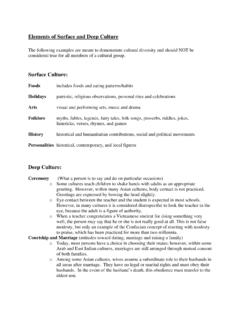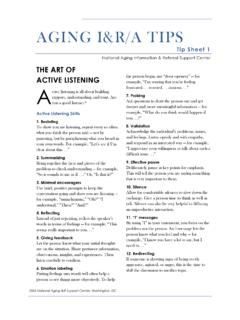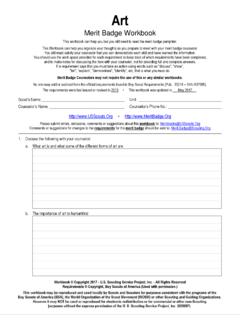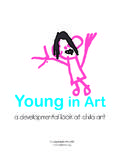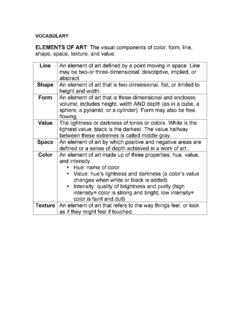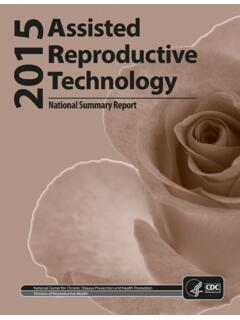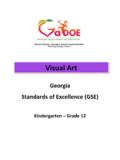Transcription of Op28 Art Room Safety - paec.org
1 PAEC Risk Manual and Safety Manual 2003 1 ART room Safety Catastrophic Risks Catastrophes associated with art rooms include ??Fires originating with kilns, photography chemicals and flammable chemicals such as paint thinners and removers. Common Hazards Frequently reported art room accidents include: ??Burns from kilns ??Inhalation of fumes from heated glazes and sprays ??Eye injuries associated with chemical splashes, flying chips, and airborne dusts ??Cuts when using scissors, knives and carving chisels ??Slips/falls on spilled liquids ??Poisoning from chemical misuse Accident Prevention To minimize the potential for accidents to occur in art rooms, these procedures should be adopted: ??The staff should review the "Art room Safety Rules" provided in this chapter. Staff members should sign the closing statement of the Rules.
2 This signed document should be forwarded to the School Personnel Office. ??Before students begin a new art project, Safety rules should be presented to students. The instructor should verify that students understand the rules. The appropriate section of the " Art room Safety Rules" can be used as a guide for the instructors' presentation. ??A formal weekly inspection should be completed utilizing a checklist. A sample checklist is provided in this chapter to assist in development of a customized checklist for each classroom. Completed inspection checklists should be maintained by the instructor for a period of three years. PAEC Risk Manual and Safety Manual 2003 2 ART room Safety RULES 1. the art staff and students should know the hazards of materials used in the classroom and should follow all manufacturer's instructions for use.
3 These instructions should include personal protective equipment required, guidelines for storage, and procedures for safe use. 2. Safety and health precautions should be posted and reviewed with students prior to any activities. 3. There will be no asbestos-containing materials, lead based glazes, and benzene in the classroom. 4. All spray painting must be done outside or with an approved operational exhaust system, and away from ignition sources. 5. Aisles should be kept clear at all times to insure prompt evacuation in the event of an emergency. 6. Keep storage of paper goods to a minimum to reduce the potential of fire. 7. Use, storage and disposal of chemicals per manufacturers' recommendations. 8. Knives and other sharp instruments should be maintained, handled, and stored safely. Allow adequate distance between individuals to prevent accidents while in class use.
4 9. Use of electrical appliances/tools to heat, mix, spray, burn, etch, etc. should be in accordance with the manufacturers' Safety instructions. Maintain safe distances between individuals to prevent accidents. 10. All electrical appliances/tools should be turned off when not in use. If appliances/tools are heated, allow them to cool in a safe place before storage. 11. The Chemical Hazard Communication Program will be followed. PAEC Risk Manual and Safety Manual 2003 1 Use of Ceramic Kilns 1. A sign must be posted when the kiln is in operation stating that it is hot and no one should be allowed near it. 2. Kilns must not be started or unloaded by students. Only the staff should fire and unload the kiln. In use or hot Kilns should not be left on overnight unless supervised. 3. Use only glazes labeled non-toxic or safe for use on eating utensils.
5 4. Kiln cords and plugs should be checked regularly. Any wearing, fraying or other damage must be corrected prior to kiln operation. 5. All exhaust fans must be operated during firing periods. Kilns should be ventilated per Manufacturer's specification prior to any use. 6. All kilns should be inspected at least annually by an approved vendor. _____ _____ Signature Date PAEC Risk Manual and Safety Manual 2003 ART room Safety INSPECTION (sample) School_____ 1. Are procedures for storage of chemical materials followed in strict accordance with manufacturers' instructions? Yes No 2. Is appropriate personal protective equipment worn when using chemical materials? (Check manufacturers' instructions for recommended personal protective equipment) Yes No 3. Are Safety and health precautions posted in appropriate work areas?
6 Yes No 4. Have all asbestos-containing materials, lead based glazes and benzene been removed and disposed of properly? Yes No 5. Is all spraying done outside or with a functioning exhaust system, away from ignition sources? Yes No 6. Are all aisles, doors and other means of egress unobstructed? Yes No 7. Is a sign posted at the kiln indicating that it is on and therefore, hot when it is in use? Yes No 8. Can only staff members fire and unload the kiln? Yes No 9. Are all glazes used in the art room labeled non-toxic or safe for use on eating utensils ? Yes No 10. Are adequate exhaust fans operated during kiln firing periods per manufactures specifications? Yes No 11. Are kilns ventilated and operated per manufacturer's specifications? Yes No 12. The Chemical Hazard Communication Program is in place and up to date?
7 Yes No 13. Have all students/staff reviewed the art room Safety Rules ? Yes No 14. If No's are checked, follow-up is needed. The principal should designate the appropriate corrective action, such as a work order. _____ _____ Inspector Date
